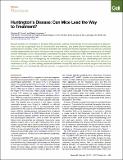Huntington's Disease: Can Mice Lead the Way to Treatment?
Author(s)
Crook, Zachary Ryan; Housman, David E
DownloadHousman_Huntington's disease.pdf (507.2Kb)
PUBLISHER_POLICY
Publisher Policy
Article is made available in accordance with the publisher's policy and may be subject to US copyright law. Please refer to the publisher's site for terms of use.
Terms of use
Metadata
Show full item recordAbstract
Mouse models for Huntington's Disease (HD) and HD patients demonstrate motor and behavioral dysfunctions, such as progressive loss of coordination and memory, and share similar transcriptional profiles and striatal neuron atrophy. Clear differences between the mouse and human diseases include almost complete striatal degeneration and rarity of intranuclear inclusions in HD, and the fact that mice expressing full-length mutant huntingtin do not demonstrate a shortened life span characteritstic of HD. While no clinical interventions tested in mouse models to date have delayed disease progression, the mouse models provide an invaluable tool for both investigating the underlying pathogenic processes and developing new effective therapies. Inherent differences between humans and mice must be considered in the search for efficacious treatments for HD, but the striking similarities between human HD and mouse models support the view that these models are a biologically relevant system to support the identification and testing of potential clinical therapies.
Date issued
2011-02Department
Massachusetts Institute of Technology. Department of Biology; Koch Institute for Integrative Cancer Research at MITJournal
Neuron
Publisher
Elsevier
Citation
Crook, Zachary R., and David Housman. “Huntington s Disease: Can Mice Lead the Way to Treatment?” Neuron 69, no. 3 (February 2011): 423-435. Copyright © 2011 Elsevier Inc.
Version: Final published version
ISSN
08966273
1097-4199